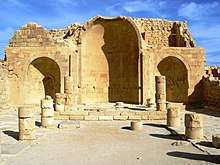Shivta
Shivta (Hebrew: שבטה, Arabic: شبطا) is an ancient city in the Negev Desert of Israel located 43 kilometers southwest of Beersheba.[1] Shivta was declared a UNESCO World Heritage Site in June 2005.
שבטה شبطا | |
 Ruins of a church at Shivta | |
 Shown within Israel | |
| Location | Southern District, Israel |
|---|---|
| Region | Negev |
| Coordinates | 30.88°N 34.63°E |
| Type | Settlement |
| History | |
| Abandoned | 8th/9th century |
| Cultures | Nabataean, Byzantine |
| Site notes | |
| Excavation dates | 1933-1934 |
| Condition | In ruins |
| Official name | Incense Route - Desert Cities in the Negev (Haluza, Mamshit, Avdat and Shivta) |
| Type | Cultural |
| Criteria | iii, v |
| Designated | 2005 (29th session) |
| Reference no. | 1107 |
| State Party | Israel |
| Region | Europe and North America |
History
Long considered a classic Nabataean town on the ancient spice route, archaeologists are now considering the possibility that Shivta was a Byzantine agricultural colony and a way station for pilgrims en route to the Saint Catherine's Monastery in the Sinai Peninsula.
Roman ruins from the first century BCE have been unearthed in the southern part of the town, but most of the archaeological findings date to the Byzantine period. Shivta's water supply was based on surface runoff collected in large reservoirs.[2]

Three Byzantine churches (a main church and two smaller churches), 2 wine-presses, residential areas and administrative buildings have been excavated at Shivta. After the Arab conquest in the 7th century CE, the population dwindled. It was finally abandoned in the 8th or 9th Century CE.
In 1933–34, American archaeologist Harris D. Colt conducted a dig at Shivta. The house he lived in bears an inscription in ancient Greek that reads: “With good luck. Colt built (this house) with his own money."[2]
The wine presses at Shivta give an insight into the scale of wine production at the time.[3] According to the calculations of archaeologists, the Nabatean/Byzantine village of Shivta produced about two million liters of wine.[4]
Adjacent to the site is a large farm that uses Nabatean agricultural techniques of irrigation, sowing and reaping.[5]
See also
References
- Segal, Arthur (1985-01-01). "Shivta-A Byzantine Town in the Negev Desert". Journal of the Society of Architectural Historians. 44 (4): 317–328. doi:10.2307/990111. JSTOR 990111.
- Shivta National Park
- "Deep in the desert". highbeam.com. 2012-08-16. Archived from the original on 2015-09-24. Retrieved 29 September 2016.
- No sour grapes, Jerusalem Post
- "A hop, skip and a jump into the past". Retrieved 2016-09-29.
Bibliography
- Tepper, Yotam; Bar-Oz, Guy (2016-05-04). "Shivta Preliminary Report" (128). Hadashot Arkheologiyot – Excavations and Surveys in Israel. Cite journal requires
|journal=(help) - Erickson-Gini, Tali (2013-12-16). "Shivta Final Report" (125). Hadashot Arkheologiyot – Excavations and Surveys in Israel. Cite journal requires
|journal=(help)
- Constanze Röhl: Shivta, Architektur und Gesellschaft einer byzantinischen Siedlung im Negev. Cologne (PhD thesis) 2010 (online)
External links
- Pictures of Shivta
- 360 degrees panorama of Shivtah
- Incense Route - Desert Cities in the Negev, UNESCO
- I due Battisteri di Shivta su BeWeB - Beni ecclesiastici in web